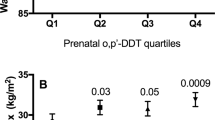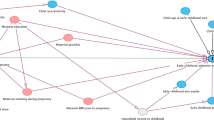Abstract
Many suspected breast cancer risk factors, including the pesticide dichlorodiphenyltrichloroethane (DDT) and its metabolite dichlorodiphenyldichloroethylene (DDE), are stored in fat where they could influence carcinogenesis. We tested the hypothesis that the relationship of DDT and DDE (DDTs) with adiposity is modified by disposition to develop breast cancer. We predicted that concentrations of serum DDTs would be inversely correlated with body mass index (BMI) during active exposure when DDTs move into the larger fat pool. We described this correlation at an average of 17 years before breast cancer was diagnosed, in a prospective nested case–control study in the Child Health and Development Studies. Women entered the study during pregnancy from 1959 to 1966 when DDT was in active use. In total, 133 breast cancer cases were diagnosed under the age of 50 as of 1998. Mean time to diagnosis was 17 years. In total, 133 controls were matched to cases on birth year. We observed the expected inverse correlation of serum DDTs with BMI only in women who remained cancer-free and not in women who ultimately developed breast cancer (p for interaction < 0.05). Findings suggest that vulnerability to breast cancer before the age of 50 may be associated with an uncoupling of the inverse correlation between BMI and serum DDTs. Investigation into mechanisms may eventually reveal early biomarkers of breast cancer risk.
This is a preview of subscription content, access via your institution
Access options
Subscribe to this journal
Receive 6 print issues and online access
$259.00 per year
only $43.17 per issue
Buy this article
- Purchase on Springer Link
- Instant access to full article PDF
Prices may be subject to local taxes which are calculated during checkout

Similar content being viewed by others
References
van den Berg BJ, Christianson RE, Oechsli FW. The California Child Health and Development Studies of the School of Public Health, University of California at Berkeley. Paediatr Perinat Epidemiol. 1988;2:265–82.
Susser E, Buka S, Schaefer CA, Andrews H, Cirillo PM, Factor-Litvak P, et al. The Early Determinants of Adult Health Study. J Dev Orig Health Dis. 2011;2:311–21.
Link BG, Susser ES, Factor-Litvak P, March D, Kezios KL, Lovasi GS, et al. Disparities in self-rated health across generations and through the life course. Social Science &. Medicine. 2017;174:17–25.
Whittemore AS, Cirillo PM, Feldman D, Cohn BA. Prostate specific antigen levels in young adulthood predict prostate cancer risk: results from a cohort of Black and White Americans. J Urol. 2005;174:872–6. discussion 876
Cohn BA, Wolff MS, Cirillo PM, Sholtz RI. DDT and breast cancer in young women: new data on the significance of age at exposure. Environ Health Perspect. 2007;115:1406–14.
Cohn BA, Cirillo PM, Christianson RE. Prenatal DDT exposure and testicular cancer: a nested case-control study. Arch Environ Occup Health. 2010;65:127–34.
Cohn BA, Cirillo PM, Sholtz RI, Ferrara A, Park JS, Schwingl PJ. Polychlorinated biphenyl (PCB) exposure in mothers and time to pregnancy in daughters. Reprod Toxicol. 2011;31:290–6.
Cohn BA. Developmental and environmental origins of breast cancer: DDT as a case study. Reprod Toxicol. 2011;31:302–11.
Cohn BA, La Merrill M, Krigbaum NY, Yeh G, Park JS, Zimmermann L, et al. DDT Exposure in Utero and Breast Cancer. J Clin Endocrinol Metab. 2015;100:2865–72.
U. S. Environmental Protection Agency. DDT, a review of scientific and economic aspects of the decision to ban its use as a pesticide. Washington, D.C.: United States Environmental Protection Agency; 1975. Report no: EPA-540/1-75-022.
Loomis D, Guyton K, Grosse Y, El Ghissasi F, Bouvard V, Benbrahim-Tallaa L, et al. Carcinogenicity of lindane, DDT, and 2,4-dichlorophenoxyacetic acid. Lancet Oncol. 2015;16:891–2.
Morgan D, Roan CC. The metabolism of DDT in man. In: Hayes WJ, editor. Essays in Toxicology, vol. 5. Academic Press: New York and London; 1975. pp 39–97.
Aronson KJ, Miller AB, Woolcott CG, Sterns EE, McCready DR, Lickley LA, et al. Breast adipose tissue concentrations of polychlorinated biphenyls and other organochlorines and breast cancer risk. Cancer Epidemiol Biomark Prev. 2000;9:55–63.
La Merrill M, Emond C, Kim MJ, Antignac JP, Le Bizec B, Clement K, et al. Toxicological function of adipose tissue: focus on persistent organic pollutants. Environ Health Perspect. 2013;121:162–9.
Mangum LH, Crow JA, Stokes JV, IIIGE Howell, Ross MK, Pruett SB, et al. Exposure to p,p′-DDE alters macrophage reactivity and increases macrophage numbers in adipose stromal vascular fraction. Toxicol Sci. 2016;150:169–77.
La Merrill M, Karey E, Moshier E, Lindtner C, La Frano MR, Newman JW, et al. Perinatal exposure of mice to the pesticide DDT impairs energy expenditure and metabolism in adult female offspring. PLoS ONE. 2014;9:e103337.
Howell GE, Meek E, Kilic J, Mohns M, Mulligan C, Chambers JE. Exposure to p,p′-dichlorodiphenyldichloroethylene (DDE) induces fasting hyperglycemia without insulin resistance in male C57BL/6H mice. Toxicology. 2014;320:6–14.
Howell G, Mangum L. Exposure to bioaccumulative organochlorine compounds alters adipogenesis, fatty acid uptake, and adipokine production in NIH3T3-L1 cells. Toxicol Vitr. 2011;25:394–402.
La Merrill M, Kuruvilla BS, Pomp D, Birnbaum LS, Threadgill DW. Dietary fat alters body composition, mammary development, and cytochrome p450 induction after maternal TCDD exposure in DBA/2J mice with low-responsive aryl hydrocarbon receptors. Environ Health Perspect. 2009;117:1414–9.
Wolff M, Anderson H. (letter) Correspondence re: J. M. Schildkraut et al., Environmental contaminants and body fat distribution. Cancer Epidemiol. Biomark. Prev., 8: 179-183, 1999. Cancer Epidemiol Biomark Prev. 1999;8:951–2.
Phillips DL, Pirkle JL, Burse VW, Bernert JT, Henderson LO, Needham LL Chlorinated hydrocarbon levels in human serum: effects of fasting and feeding. Arch Environ Contam Toxicol. 1989;18:495–500.
Schisterman EF, Whitcomb BW, Louis GM, Louis TA. Lipid adjustment in the analysis of environmental contaminants and human health risks. Environ Health Perspect. 2005;113:853–7.
Wolff MS, Anderson HA, Britton JA, Rothman N. Pharmacokinetic Variability and Modern Epidemiology The Example of Dichlorodiphenyltrichloroethane, Body Mass Index, and Birth Cohort. Cancer Epidemiol Biomark Prev. 2007;16:1925–30.
Siiteri PK, Simberg N, Murai J. Estrogens and Breast Cancer. Ann N Y Acad Sci. 1986;464:100–6.
Gershkovich P, Shtainer D, Hoffman A. The effect of a high-fat meal on the pharmacodynamics of a model lipophilic compound that binds extensively to triglyceride-rich lipoproteins. Int J Pharm. 2007;333:1–4.
National Institute of Environmental Health Sciences. Breast cancer and the environment: prioritizing prevention. Interagency breast cancer and environmental research coordinating committee; 2013. https://www.niehs.nih.gov/about/boards/ibcercc/index.cfm.
Acknowledgements
We thank the late Jacob Yerushalmy who founded the Child Health and Development Studies (CHDS), the late Barbara J. van den Berg, the second director of the CHDS, and Roberta Christianson, all CHDS staff, and the more than 15,000 CHDS families who participated in the CHDS for making this work possible. We thank Mary Wolff for DDT assays. We acknowledge the late Pentti Siiteri for suggesting that we investigate how BMI might impact the effects of lipophilic environmental chemicals. This research was supported by the National Cancer Institute (R01 CA72919), the National Institute for Child Health and Development (N01 HD 6 3258 and N01 HD 1 3334), National Institute for Environmental and Health Sciences (R01 ES024946), the U.S. Department of Agriculture’s National Institute of Food and Agriculture (Hatch project 1002182/CA-D-ETX-2233-H), and the California Office of Environmental Health Hazard Assessment (16-E0032). The collection of cancer incidence data used in this study was supported by the California Department of Public Health as part of the statewide cancer-reporting program mandated by California Health and Safety Code Section 103885; the National Cancer Institute’s Surveillance, Epidemiology, and End Results Program under Contract HHSN261201000140C (awarded to the Cancer Prevention Institute of California), Contract HHSN261201000035C (awarded to the University of Southern California), and Contract HHSN261201000034C (awarded to the Public Health Institute); and the Centers for Disease Control and Prevention’s National Program of Cancer Registries, under Agreement U58DP003862-01 (awarded to the California Department of Public Health).
Author information
Authors and Affiliations
Corresponding author
Ethics declarations
Conflict of interest
BAC and PMC have received funding from the National Institutes of Health and the California Breast Cancer Research Program for their work. MALM has received funding from the National Institutes of Health and the CalEPA for her work.
Electronic supplementary material
Rights and permissions
About this article
Cite this article
Cohn, B.A., Cirillo, P.M. & La Merrill, M.A. Correlation of body mass index with serum DDTs predicts lower risk of breast cancer before the age of 50: prospective evidence in the Child Health and Development Studies. J Expo Sci Environ Epidemiol 29, 302–309 (2019). https://doi.org/10.1038/s41370-018-0072-7
Received:
Revised:
Accepted:
Published:
Issue Date:
DOI: https://doi.org/10.1038/s41370-018-0072-7



